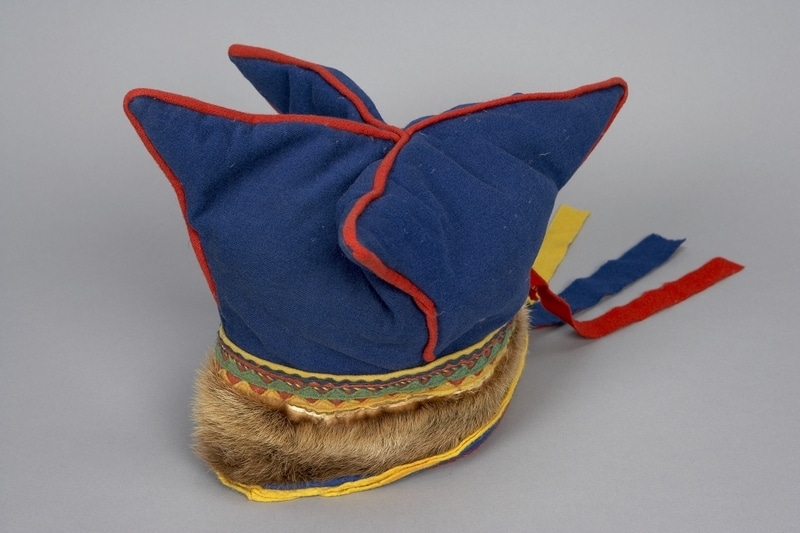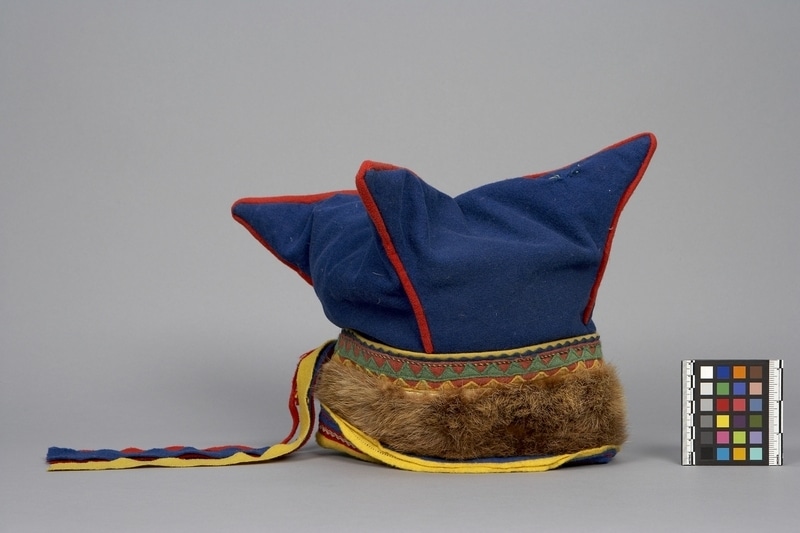Four Winds Hat Item Number: 1128/1 from the MOA: University of British Columbia




Description
Man's hat. Trimmed with a band of fur, bands of rickrack and appliqued fabric; multi-coloured fabric streamers at centre back. The dark blue four-pointed crown is edged in red. Lined with off-white, red and blue cotton flannelette. Points of the crown are stiffened with an unseen material (possibly the spines of large feathers?).
History Of Use
Sami clothing, made predominantly of blue felt, is decorated with multi-coloured, geometrically cut pieces of cloth, rickrack and braid designs specific to families and regional groups, meant to allow people to distinguish relatives and strangers at a distance. Men's hats differ from women's both in form and pattern. The Sami homelands (Sapmi) cover northern Scandinavia and northwestern Russia. Some Sami are coastal dwellers, living year-round in small communities as fishers. Many are transient reindeer herders, moving their herds seasonally between coastal and mountain pastures.
Narrative
The hat belonged to Per Utsi, from the town of Porjus. He was a member of the Karesuando Sami.
Iconographic Meaning
The four points of the hat represent the four winds. A Sami legend tells how the four winds used to blow from all directions at the same time, until a wise man suggested that each take a turn at being the most powerful. Since then, Sami men have worn four wind hats, called čiehgahpir.
Specific Techniques
Four Winds hats are made from boiled felt and lined with down.
Item History
- Made in Sweden between 1950 and 1970
- Collected during 1981
- Owned by Wilhelm Helmer before May 29, 1986
- Received from Wilhelm Helmer (Seller) and Ruth Read Bequest (Funding source) on May 29, 1986
What
- Name
- Four Winds Hat
- Identification Number
- 1128/1
- Type of Item
- hat
- Material
- wool fibre, cotton fibre, reindeer skin, feather ? and dye
- Manufacturing Technique
- cut, sewn and appliqued
- Overall
- height 25.0 cm, width 29.0 cm, depth 29.0 cm
Who
- Culture
- Sami
- Previous Owner
- Wilhelm Helmer
- Received from
- Wilhelm Helmer (Seller) and Ruth Read Bequest (Funding source)
Where
- Holding Institution
- MOA: University of British Columbia
- Made in
- Sweden
When
- Creation Date
- between 1950 and 1970
- Collection Date
- during 1981
- Ownership Date
- before May 29, 1986
- Acquisition Date
- on May 29, 1986
Other
- Item Classes
- textiles
- Condition
- excellent
- Current Location
- Case 47
- Accession Number
- 1128/0001